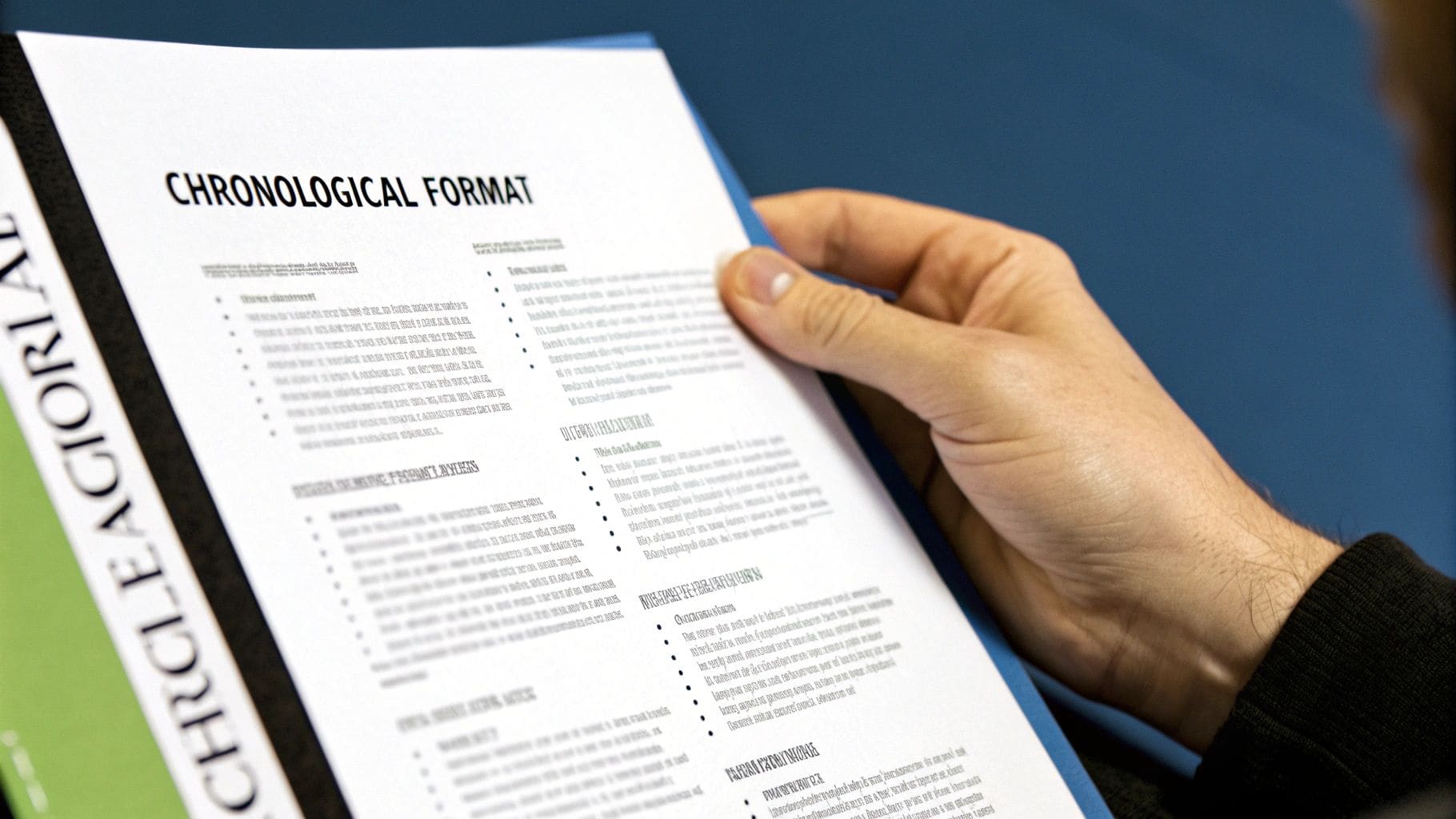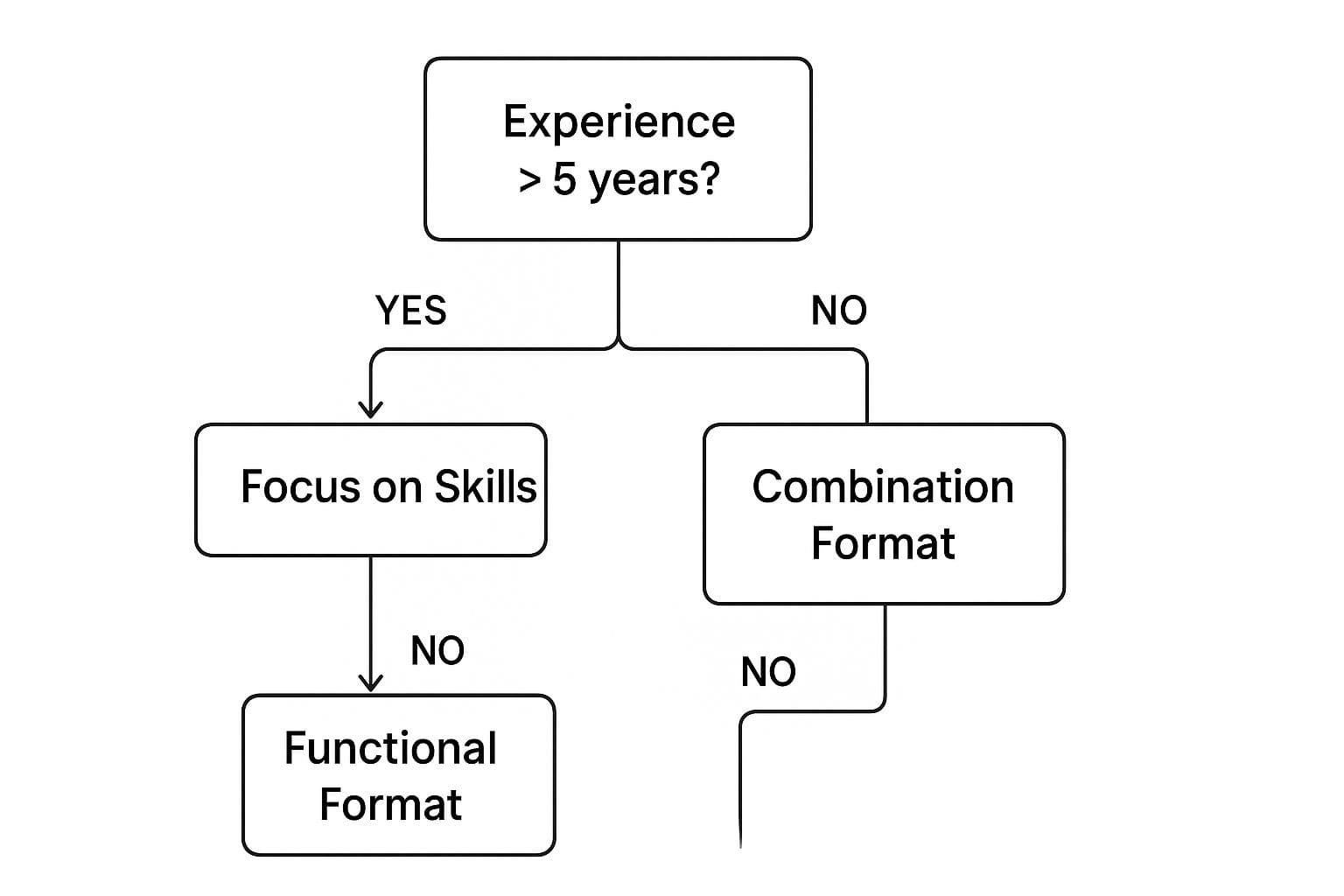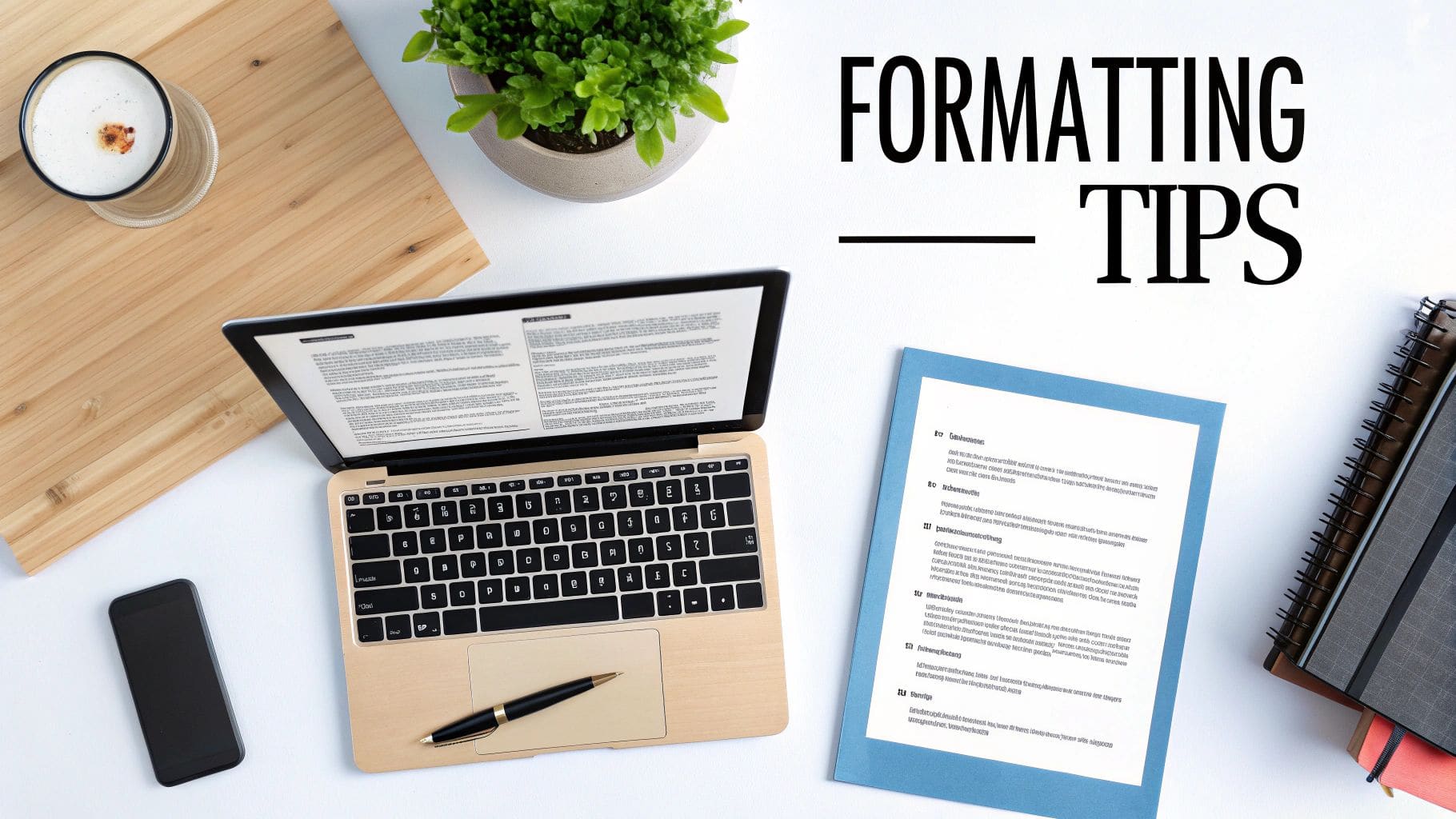Best Resume Format for Your Career | Proven Tips & Examples
Learn the top resume format to land more interviews. Explore chronological, functional, and hybrid styles with expert examples and guidance.
Best Resume Format for Your Career | Proven Tips & Examples
Choosing the right resume format is the most critical first step in your job search. The layout you select determines how a recruiter sees your skills and experience in those crucial first few seconds. This guide gives you a clear, actionable framework to select the perfect resume format—chronological, functional, or hybrid—based on your specific career situation. By the end, you'll be able to structure your resume to highlight your strengths, navigate automated screening systems (ATS), and create a compelling narrative that lands you interviews.
We'll break down each format with practical examples, showing you exactly how to frame your achievements for maximum impact. You'll learn to transform a simple list of job duties into a powerful showcase of your value, ensuring your resume not only gets past the bots but also captures the attention of a hiring manager.
Understanding Your Resume Format Options
Think of your resume format like the foundation of a house. If you get it right, everything you build on top of it—your skills, your experience, your story—will be strong and stable. Get it wrong, and the whole thing can feel a bit shaky. This is especially true today, as outdated layouts are often the first to get tossed out by modern Applicant Tracking Systems (ATS).
The hiring game has changed, and resumes have had to change with it. Today, there are a few key resume formats you'll see out in the wild. While they all stem from the main three, modern variations are specifically designed to navigate both automated filtering and the intense competition for good roles.
Why Your Layout Matters So Much
Your resume's structure does more than just organize information; it tells a story about your professional journey at a glance. A well-chosen format can be your secret weapon.
It can:
- Shine a spotlight on your biggest strengths, putting your most impressive qualifications right where a recruiter can't miss them.
- Downplay potential weaknesses, like a gap in your employment history or a complete career change.
- Make it incredibly easy to read, which is crucial when recruiters spend just a few seconds on each application.
Choosing the right structure is one of the hard and fast rules for writing an effective CV because it frames your entire narrative. It's also worth understanding what makes a modern format for a resume so effective in today's job market.
Quick Resume Format Selector
Feeling a bit lost? This table breaks it down to help you quickly pinpoint the best format for your situation.
| Resume Format | Best For | Key Feature |
|---|---|---|
| Chronological | Professionals with a consistent career path | Highlights a clear, upward progression in your work history. |
| Functional | Career changers, students, or those with gaps | Emphasizes skills and abilities over a linear work timeline. |
| Combination | Experienced pros or those in specialized fields | Blends a skills summary with a detailed work history. |
Think of this as your starting point. Now, let's dig into what makes each of these formats tick and figure out which one will tell your story best.
Get your free CV review
Upload your CV and get instant AI suggestions to improve your chances
The Chronological Resume: The Recruiter's Favorite

The chronological resume is the undisputed heavyweight champion of the resume world. It's the layout recruiters know, trust, and frankly, prefer to see. The structure is simple: it lists your work history in reverse-chronological order, meaning your most recent job sits right at the top.
Think of it like telling your career story starting from the latest chapter and working backward. This straightforward approach makes it incredibly easy for a busy hiring manager to see your career trajectory, your stability, and how you've grown over time. For anyone with a solid work history without major gaps, this is your go-to format.
Another huge plus? This format is king when it comes to Applicant Tracking Systems (ATS). These software gatekeepers can easily scan the simple, linear layout, making sure your details get parsed correctly and actually land in front of a human.
From Duties to Achievements
The biggest pitfall with this format is creating a boring list of job duties. To make your chronological resume pop, you absolutely have to frame your experience in terms of achievements. Your goal is to shift from what you were responsible for to what you actually accomplished.
Instead of this snooze-fest:
- Responsible for managing social media pages
- Wrote blog posts for the company website
Try this powerhouse version:
- Grew social media engagement by 35% in six months by developing a new content strategy.
- Wrote and published 15+ SEO-optimized blog posts per month, increasing organic traffic by 20%.
By putting numbers to your successes, you're not just making claims—you're providing cold, hard proof of your value. This simple shift changes the entire conversation from "what I did" to "the impact I made."
While a traditional single-column layout is still considered the safest bet for ATS, the visual landscape is changing. Recent data shows a whopping 96% of job seekers now prefer double-column designs for their modern look and feel. Fonts like Calibri and Helvetica have also pushed out the old guard, giving resumes a much cleaner, more professional vibe. You can dive into more resume trends over at Enhancv.com and see how much aesthetics matter today.
The Functional Resume For Career Changers

While the chronological resume tells a neat, linear story, the functional resume throws out the rulebook. Think of it as a skills-first format, designed to put your abilities in the spotlight instead of your work timeline. This makes it an incredibly powerful tool if you're navigating a major career change or jumping back into the workforce after some time away.
Instead of just listing jobs from newest to oldest, you group your experiences under specific skill categories. Let's say you're a teacher aiming for a corporate training role. You could create sections like "Curriculum Development," "Public Speaking," and "Stakeholder Communication" to showcase your transferable talents right at the top.
This approach immediately tells a hiring manager what you can do for them, shifting their focus away from a less-than-direct career path or any gaps in your employment history.
Why Recruiters Are Cautious
A word of warning: you have to use this format strategically. Some recruiters get a little suspicious when they see a functional resume because it can be used to hide a patchy work history or a lack of direct experience. By downplaying the timeline, you might make them wonder what you're not telling them.
The trick is to be transparent and laser-focused on relevance. Your skill groupings absolutely must connect directly to the demands of the job you're applying for.
A functional resume shifts the hiring manager's focus from "Where have you been?" to "What can you do?" It's a bold move that highlights your potential and transferable skills over a traditional career ladder.
Structuring Your Functional Resume
To build a functional resume that really works, you need to think in terms of skill "buckets" that perfectly match your target role. Here's a quick guide to organizing it:
- Contact Information: This always goes right at the top. No exceptions.
- Resume Summary: A short, punchy introduction that zeroes in on your career goals and top qualifications.
- Skills Summary: This is the heart and soul of the resume. Create 3-4 skill categories (like "Project Management," "Digital Marketing," or "Client Relations") and then list your most relevant achievements as bullet points under each one.
- Work History: Keep this part simple. Just provide a clean list of your previous employers, job titles, and dates of employment. Don't add detailed descriptions here.
- Education: Your degrees, certifications, and other qualifications can sit at the bottom.
This structure puts your most compelling qualifications front and center, making a powerful case for your abilities before the recruiter even gets to your work timeline.
The Hybrid Resume: Maximum Impact, No Compromises
Imagine a resume that leads with your absolute best qualities but still lays out a clear, easy-to-follow story of your career. That's the magic of a hybrid resume, sometimes called a combination resume. It powerfully blends the highlights of a functional format with the clarity of a chronological one, creating a document that's impossible to ignore.
This format kicks things off with a strong summary of your skills and biggest wins, immediately showing a hiring manager what you bring to the table. Right after that powerful intro, it dives into your work history in the standard reverse-chronological order everyone expects. The result? You make an incredible first impression without sacrificing the credibility that a clear career path provides.
The Best of Both Worlds
The hybrid format is the perfect middle ground. It lets you strategically pull forward key abilities that might otherwise get buried in a long list of jobs. This makes it a fantastic choice for experienced pros, specialists, or even career changers who have a ton of transferable skills to show off.
For instance, if you're a project manager, you could create a "Key Accomplishments" section right at the top to feature your most successful projects before the hiring manager even gets to your job list. You're taking control of the story, making sure the most important stuff gets seen first.
Think of the hybrid resume as a movie trailer for your career. It opens with the most exciting highlights to grab attention, then follows up with the full story for context and depth.
Who Should Use a Hybrid Resume?
This layout is a game-changer for anyone who needs to balance showcasing deep skills with a solid work history. It's an especially smart move if you are:
- An experienced professional: You can put years of hard-won skills and major achievements right at the top where they belong.
- A technical specialist: Someone in IT or engineering can create dedicated sections for programming languages, software, or specific tech stacks.
- A career changer: It allows you to spotlight the transferable skills that are most relevant to the new job you're targeting, connecting the dots for the recruiter.
Ultimately, the hybrid format offers a balanced and strategic way to frame your entire career. It puts your most impressive qualifications front and center while still giving recruiters the clear, chronological work history they need to see. It's all about maximizing your impact from the very first glance.
How to Select the Perfect Resume Format
Choosing the right resume format isn't about picking a template you like the look of. It's a strategic decision. Think of it as choosing the perfect frame for a picture—the right one makes your best features pop, while the wrong one can be distracting. Your goal is to tell your career story in a way that immediately highlights your biggest strengths.
This choice has a huge impact on how a recruiter sees your experience in those first few seconds. A well-chosen format makes your value instantly clear, guiding their eyes straight to your most impressive wins.
Matching Your Career to a Resume Format
Every job seeker's story is different. A recent graduate needs to put their skills and potential front and center, making up for a shorter work history. An executive, on the other hand, needs to showcase a long, steady climb of leadership and proven results. The right format solves these problems by letting you control the narrative.
For example, a freelancer with a dozen different projects for various clients would look scattered on a traditional resume. But with a hybrid format, they can group those projects under skill headings like "Content Strategy" or "Project Management," turning a chaotic history into a compelling showcase of expertise.
In contrast, someone with a clear, upward career path—say, from Junior Analyst to Senior Director at the same company—should absolutely use the chronological format. It's the best way to show off that impressive progression.
This simple decision tree can help you see which format best fits where you are in your career.

As you can see, a long and steady work history points directly to a chronological layout. If you're more focused on what you can do rather than where you've been, a functional or hybrid resume is probably a better fit.
No matter which format you choose, you need to make sure it can be read by applicant tracking systems (ATS). Using a tested ATS-friendly resume template ensures your carefully crafted story actually makes it to a human reader.
The key takeaway: Don't just list your experience; present it. The perfect resume format is the one that tells your story most persuasively, ensuring your best qualifications are the first thing a recruiter sees.
Common Formatting Mistakes That Cost You Interviews
You can have the most impressive career in the world, but if your resume format is a mess, it's all for nothing. Even tiny mistakes—like an unprofessional font or a wonky layout—can send your application straight to the "no" pile before anyone even reads about what you've accomplished.
https://www.youtube.com/embed/_qWi6vp_0t4
These seemingly small errors scream a lack of attention to detail, a major red flag for any role. The truth is, an otherwise perfect resume can be completely sunk by a few simple, avoidable slip-ups.
Typos and Grammatical Errors
This is, without a doubt, the number one resume killer. Your resume isn't just a list of jobs; it's a demonstration of your professionalism, and precision is everything. Research shows that a staggering 77% of hiring managers will immediately toss a resume that has typos or grammar mistakes. There's no room for error here.
In fact, after analyzing over half a million resumes, one study found that candidates with over 99% spelling accuracy were three times more likely to get hired. Always proofread your resume. Then proofread it again. Better yet, have a friend or a tool give it a final once-over. You can see more on how these small details make a big impact in this resume statistics deep-dive.
Overlooking ATS Compatibility
Before your resume ever reaches human eyes, it first has to get past the gatekeepers: Applicant Tracking Systems (ATS). Most companies use these software systems to scan and filter applications, and they get confused by anything too fancy.
To make sure your resume sails through this initial robot scan, you have to keep things simple. Avoid:
- Fancy fonts: Just stick to the classics. Think Calibri, Arial, or Helvetica.
- Columns and tables: An ATS can't read these properly and often scrambles your information into nonsense.
- Headers and footers: You might think it looks clean, but the ATS can completely miss critical information like your contact details if they're placed here.
Your resume has two audiences: a robot and a human. A clean, simple resume format is the only way to satisfy both. Fail the first, and you'll never reach the second.
Frequently Asked Questions About Resume Formats

Still have a few questions? You're not alone. Here are some quick answers to the most common things job seekers ask when picking the perfect resume format.
Should I Use a One or Two-Page Resume?
This is the classic resume debate, but the answer is pretty straightforward. If you have under 10 years of experience, stick to a single, powerful page. It forces you to be concise and focus on what truly matters.
For seasoned professionals with a long track record of relevant wins, a two-page resume is not only acceptable but often necessary. The key isn't length; it's relevance. Don't add fluff just to fill space.
What Is the Best Resume Format for ATS?
When you're up against the bots—the Applicant Tracking Systems (ATS)—your best bet is the reverse-chronological format. Its clean, linear structure is exactly what these systems are designed to read easily.
To keep the ATS happy, avoid fancy tables, columns, and graphics that can scramble the software. It's also a good idea to think about what tense your resume should be in to maintain clarity and consistency.
It's crucial to understand why certain resume templates blur together for recruiters during that initial scan. The last thing you want is to be dismissed before a human even sees your name.
--- Ready to build a resume that actually gets noticed? CV Anywhere instantly turns your career story into a professional, interactive web page that stands out. Build your modern resume for free and make an unforgettable first impression.
Tags
Related Articles
Create a Stunning Resume with Our Resume AI Builder
Create a Stunning Resume with Our Resume AI Builder This guide is your complete walkthrough for using a resume AI builder to create a professional, effective document that actually opens doors and lan...
Read more →9 High-Impact Skills to Add in Resume for 2025
9 High-Impact Skills to Add in Resume for 2025 Your resume is more than a record of your work history; it's a strategic marketing document designed to secure your next interview. In a crowded job mark...
Read more →A Practical Guide to Using Resume Templates Effectively
Picking the right resume templates is your first—and most important—move in getting a recruiter's attention. It's not just about looks; a great template is a strategic tool. It organizes your career s...
Read more →Popular Articles
Finding the right cv template google docs can be a great starting point for your job search, but it's often not the most effective path to getting hired. Whilst templates offer a visual framework, the...
The best way to craft a comprehensive and professional CV of curriculum vitae is with a dedicated tool like CV Anywhere's CV builder. It ensures your document is perfectly formatted and optimised to h...
Stop searching for the perfect template of resume. Trawling through hundreds of options to find one that fits your experience is an outdated, frustrating process. The solution isn't a better template;...
Here is a detailed breakdown of the 12 best options for a resume maker for free available today. We've done the research for you, so you can stop searching and start building a professional, job-winni...
Picking the right resume templates is your first—and most important—move in getting a recruiter's attention. It's not just about looks; a great template is a strategic tool. It organizes your career s...